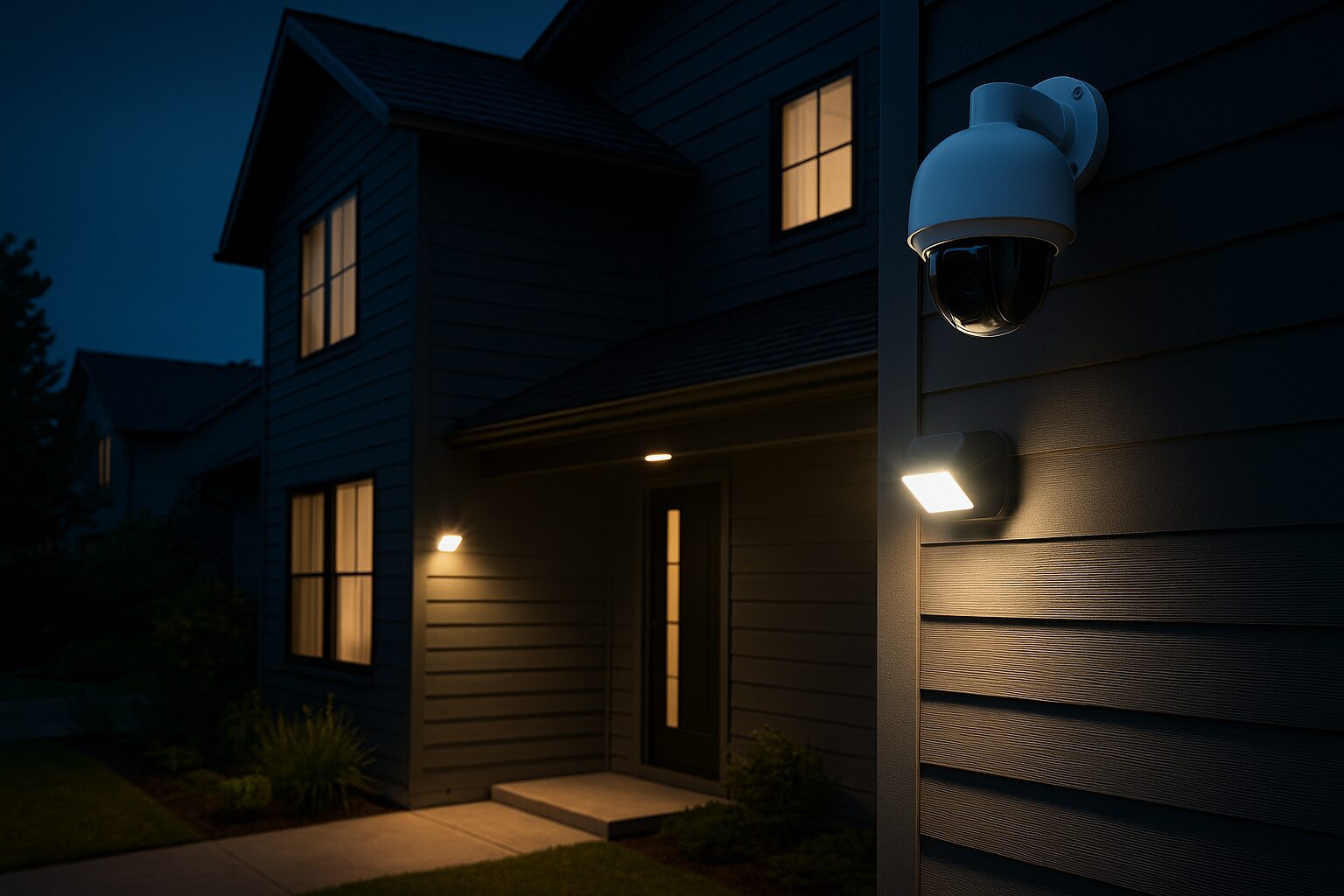
So you want to fortify your home like a covert ops team — love the ambition. Here’s the thing: there’s a big difference between clever, legal security and spy-movie illegal nonsense. This piece gives the smart, lawful, and actually effective moves that look tactical without turning you into a felon. Think quiet competence, not theatrics.
1) Think like an adversary — then shut that plan down
Pros don’t improvise; they plan. Walk your property at night, daytime, and during times you’re usually out. Identify predictable weaknesses: dark corners, unsecured gates, easy-to-see valuables through windows, or a single path that all foot traffic uses. Close those gaps with lighting, trimmed landscaping, and redundant access controls. This isn’t glamour — it’s boring, effective prevention.
Now escalate that: imagine not just one intruder but three different profiles — the opportunist, the professional thief, the courier of problems — and ask what each would exploit. That mental exercise forces you to patch a range of threats instead of one lucky scenario. Sort the fixes into “cheap and immediate” (trim hedges, fix a porch light) and “invest and defer” (fence upgrades, camera network), then start with the cheap wins.
Finally, don’t forget the human side: your habits. The best-designed fortress fails because someone left the back gate open or announced a week-long trip on public social media. Harden routines as much as hardware — make unpredictability part of your operational baseline so potential troublemakers can’t pattern-match your life.
2) Layered security > single flashy gadget
One lock is a suggestion; layered security is a policy. Combine good-quality deadbolts, window locks, reinforced strike plates, motion-sensing exterior lights, and visible cameras. Make the cost of a break-in higher (time, exposure, noise). Importantly, choose products and installers with warranties and certifications — reliability beats gimmicks every time.
Layering isn’t just redundancy; it’s a sequence. A visible camera bolsters a strong door, which backs up an alarm, which is monitored — if one fails, another still imposes cost. Consider the “cost curve” for an intruder: raise noise, raise time, raise detection — make them pick a different house. That psychological calculus is as decisive as any tech.
Also, think maintenance. A multi-layer setup only works if someone keeps it running. Make a quarterly checklist: test locks, trim sightlines near cameras, update firmware, rotate backup batteries. Systems aren’t set-and-forget — they’re set-and-service.
3) Tech that helps — and how to use it right
Modern gear is your ally: doorbell cams, encrypted Wi-Fi security cameras, smart locks with multi-factor access, and monitored alarm systems. BUT: configure them securely — strong passwords, two-factor authentication, and regular firmware updates. Public posts that broadcast your absence? Dangerous. Use devices to monitor and deter, not to create new attack surfaces.
Don’t forget network hygiene. Cheap cameras that ship with default passwords are invitation letters. Put security devices on a segmented Wi-Fi network, lock the router’s admin interface, and set a routine to apply updates. If your camera vendor ever announces a vulnerability, treat it like a plumbing leak — fix it immediately.
Lastly, use the tech as intelligence, not theater. Cameras should cover choke points and entry paths, not just ornamental views. Configure motion zones to reduce false alarms, and set cloud retention for at least 30 days if possible — you want usable evidence, not a two-hour loop.
4) Visibility, not secrecy
Would-be intruders look for easy entry and low visibility. Make your home look occupied: timers for lights, sound devices, parked cars rotated, curtains in normal positions. Neighborhood presence matters: create the impression of attention without turning your life into an act. Visible deterrents (camera signs, stickers) work psychologically more often than you’d expect.
But don’t fall for the cheap props only. A sticker implying monitoring without any real cameras is weak — a determined intruder will test it. Pair the psychological play with the real thing: a visible camera and a sign plus working lights is a credible profile; an empty house with fake warnings is not.
And remember subtlety matters: subtle movement in the windows, a dim porch light that cycles, the sound of a TV late at night — small cues add up to perceived occupancy. Make your house look like a lived-in project, not a vacant target.
5) Legal use-of-force basics (read your local laws)
Every jurisdiction has different rules about self-defense, warning shots, or use of force. Don’t rely on hearsay. Know the legal standard in your state or country (duty to retreat vs. castle doctrine, for example). Documented knowledge and a calm plan keep you out of court and safer in the moment. If you’re unsure, consult a licensed attorney — that’s tactical intelligence, not fear.
Also, memorize practical boundaries: what is allowed in your state concerning pursuit, detention, or reasonable force? Some places let you use force in defense of property in limited ways; others don’t. A mistaken move in the heat of the moment is not valor — it’s legal peril. Train your family on what to do: secure the kids, call police, document.
Finally, keep escalation proportional. The goal is to end a threat, not to become the headline. Even if local law is generous, public prosecutors and juries hate vigilante theater. The smartest defenders keep cool, keep legal, and let evidence and authorities handle the aftermath.
6) Nonlethal options & de-escalation
If your goal is to protect life and property, train in de-escalation and nonlethal tools. High-quality door barricades, panic buttons, pepper spray (where legal), and training in verbal commands can end or prevent a situation without lethal force. Again: legality varies. Learn what’s lawful and practice responsibly.
Get real training. A can of spray in the drawer won’t help if you don’t know how to use it under stress. Attend a certified self-defense or de-escalation course that covers legal boundaries and scenario practice. Spend time on verbal judo: decisive commands, clear instructions, and a calm tone often break an intruder’s momentum.
And if you do deploy a nonlethal tool, document and report everything immediately. Use of any force changes the legal and investigative frame of an incident; prompt calls to law enforcement and clear incident logs preserve your position and show you acted responsibly.
7) Red team your neighbors — community security
Neighborhood networks are force multipliers. Set up a community alert group, coordinate lighting schedules for vacations, and share suspicious-activity observations with neighbors and local law enforcement. Professional security relies on intel sharing — you don’t need to be secretive to be strategic.
Think of your block as a distributed sensor array: one camera, another set of eyes, someone who knows every car — those human nodes crush low-skill criminals. Run routine “security walk” meetups with committed neighbors: identify blind spots, discuss patterns, and fix weak links cooperatively.
Don’t be paranoid, be pragmatic. Gossip hurts trust; structured communication builds it. Use an encrypted group or a vetted neighborhood app; set simple rules for what to report and how. Collective attention beats lone heroics every time.
8) Prepare a plan — and rehearse it calmly
Have an emergency plan for different scenarios: home intrusion, fire, medical emergency. Decide on rally points, who calls 911, and who grabs IDs or medications. Practice once or twice, so the routine is muscle memory — stress ruins improvisation.
Role-play different timelines: one intruder inside the house, multiple intruders outside, or a late-night forced entry. Walk through who does what in each case — one person locks doors, another shepherds children, another confirms 911. The plan reduces chaos and speeds decisions.
Also, build redundancy into the plan. Phone dead? Have a small paper list of emergency contacts. Power out? Have battery-powered lights and a physical whistle. The point of rehearsal is not drama — it’s to guarantee competence under pressure.
9) Documentation and evidence chain
If a crime occurs, clear, time-stamped video, well-logged incident notes, and preserved evidence help police and prosecutors. Make sure your cameras have adequate retention and timestamps, and avoid contaminating a scene. You want to be useful to investigators, not an obstruction.
Store backups off-site or in the cloud. Write an incident timeline within hours, not days — memory fuzzes fast. If you collect physical evidence (broken glass, footprints), photograph before touching it and tell officers what you handled; preserve the chain of custody as best you can.
Finally, consider a post-incident review with an expert: what failed, what worked, what will you change? Treat every incident like an after-action report so you improve faster than the next intruder’s tactics.
10) Upgrade smartly, not theatrically
Spending money on a single, dramatic gadget (taser traps, booby traps — don’t) is both illegal and ineffective. Invest in high-quality, tested systems and professional installation. A modest, well-chosen security plan beats a Hollywood setup every day.
Budget wisely: start with the weak points identified in your Red Team and plug those first. If you have leftover funds, increase redundancy rather than buy the next gimmick. Choose warranties and responsive support — a dead camera after a break-in is worse than no camera at all.
And if you ever consider anything that could harm an intruder (booby traps, spring guns, electrified surfaces), stop. It’s illegal in most jurisdictions and guarantees legal exposure. Smart defense protects people, property, and your legal standing — not your pride.
Want to learn more tactical, legal, and practical home-defense strategies? If you liked the straight-shooting approach above, check out the deeper training and strategy packs at BlackOps Elite Strategies — they focus on legal home-protection tactics, planning, and resilience. Get Your Copy Here!
(Disclaimer: This article provides general information only, not legal advice. Laws vary by jurisdiction — consult a qualified attorney or local law enforcement for guidance specific to your area.)


